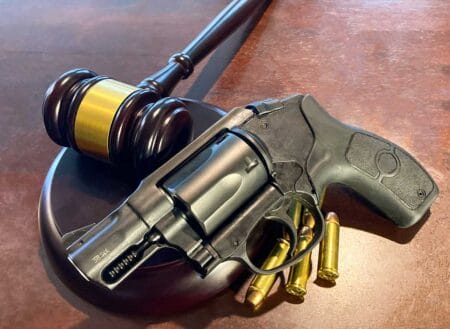
U.S.A. –-(AmmoLand.com)-– On June 29, 2022, the Supreme Court held a clean-up conference for the cases yet to be dealt with in the current term, which ends on June 30, 2022.
Four of those cases have been waiting on the decision in the NYSR&P Association v Bruen case. Bruen was decided with a strong opinion upholding the Second Amendment individual right to keep and bear arms outside the home.
All four cases have been granted certiorari, vacated by the Supreme Court, and remanded to the appropriate circuits to be heard in light of the Bruen decision.
The Bruen decision eviscerates the “two step” process and the three levels of scrutiny created in the circuits to evaluate cases. As far as enumerated rights go, “rational basis” “intermediate scrutiny” and “strict scrutiny” are dead.
It is now the burden of the state to prove any law restricting the right to keep and bear arms must have a history and tradition greater than the Sullivan law in New York. If the state cannot prove such a history and tradition exists; the law is unconstitutional under the Bruen decision.
The four cases, which have been languishing in the courts for years, are these:
- Association of NJ Rifle & Pistol Clubs v. New Jersey
- This case involves the ban on magazines of over 10 rounds by New Jersey. (Third Circuit)
- Young v. Hawaii
- This case is about the denial of Hawaii to issue carry permits for outside the home. (Ninth Circuit)
- Duncan v. Bonta
- This case involves the ban on magazines of over 10 rounds by California. (Ninth Circuit)
- Bianchi v. Frosh
- This case involve the ban on semi-automatic “assault weapons” in Maryland. (Fourth Circuit)
All four cases have been sent back to three different circuit courts of appeal, to be re-evaluated under the clear-cut rules of the Bruen decision. This is what is expected when the Supreme Court invalidates the previous system used by the various circuits over the last decade and more.
The Supreme Court has told the offending circuits: You did it wrong when you considered these laws under your convoluted two part system with a three part level of scrutiny. Evaluate them again, using the process laid out in Bruen. How long this will take is unclear.
New Jersey and California have already made policy decisions saying the “good reason” requirement in their carry permit law is now unconstitutional.
New York seems inclined to find ways to attempt to thwart the direction of the Supreme Court.
The Hawaii government appears to remain silent on the issuing of permits at the moment.
Analysis:
The Supreme Court has sent a message to the lower circuit courts. It appears to be: bans on items protected by the Second Amendment are out of bounds. Bans on the carry of firearms outside the home are out of bounds. Use the process outlined in Bruen to determine if a law has been around long enough, and has been common enough, that it was an acceptable restriction on the right to keep and bear arms in most states for the history of when the Second Amendment was ratified; and particularly when the Fourteenth Amendment was ratified.
It is hard to see how bans on magazines of more than 10 rounds (very recent) or on Semi-automatic firearms (very recent) meet these criteria.
About Dean Weingarten:
Dean Weingarten has been a peace officer, a military officer, was on the University of Wisconsin Pistol Team for four years, and was first certified to teach firearms safety in 1973. He taught the Arizona concealed carry course for fifteen years until the goal of Constitutional Carry was attained. He has degrees in meteorology and mining engineering, and retired from the Department of Defense after a 30 year career in Army Research, Development, Testing, and Evaluation.







Also, the recent SCOTUS decision regarding the EPA case seems to indicate that the EPA cannot make laws, only Congress. This means the ATF cannot make law either, in fact, no government alphabet agency may make laws.
Sullivan Act was 1911, NFA was 1934, therefore the NFA “can’t have a history and tradition greater than” the Sullivan Act.
even the machine gun rules dont hold water Gatling guns were privately owned
It doesn’t matter what SCOTUS decides, these rogue states will keep trying to do whatever they want in hopes of convincing other states to join in the fun.
This was a great victory, but the cancer of the left remains, and as with any cancer treatment “we must manage our expectations.” I expect that where there is no history either way, such as with magazine size, suppressors, and machine guns, the Court will end up reverting to the strict scrutiny analysis. I expect we might lose on magazines over 10 rounds, and we will lose on suppressors and machine guns. I’m not saying that’s right, I’m saying how the Court will rule. The reason is that neither the parties nor the Court have faced the real reason for… Read more »
There should be only one gun law on the books, Criminals should not have access to firearms. No other rules should apply.
Hopefully these also set Maura Healy in Mass on her ass too.
According to the Bruen ruling, even the mental health standard and domestic abuser prohibitions are recent regulations and could be found unconstitutional because those were not considered back in 1868 when the 14th Amend. was ratified.
The 2A could get back to only felons and fugitives being prohibited, if you think about it.
Didn’t we just leave that circus? California’s lower courts were challenged regarding the magazine ban, it was ruled unconstitutional. AG Becerra challenged the ruling and a stay was issued by the 9th Circuit Court in which later their 3 judge panel agreed with the lower court. Not to be outdone, Becerra/Bonta challenged the ruling, the stay remained in place after a full panel of judges overruled the 3 judge decision. This was supposed to go to the Supreme Court for a final say, but it now appears we have a complete circle jerk.
I feel bad for all of our blue state militia brethren who were forced to buy those ridiculously modified low-capacity AR and AK contraptions to suit the illegitimate politicians in power. Some of those weapons will be fairly difficult to change back to standard capacity.